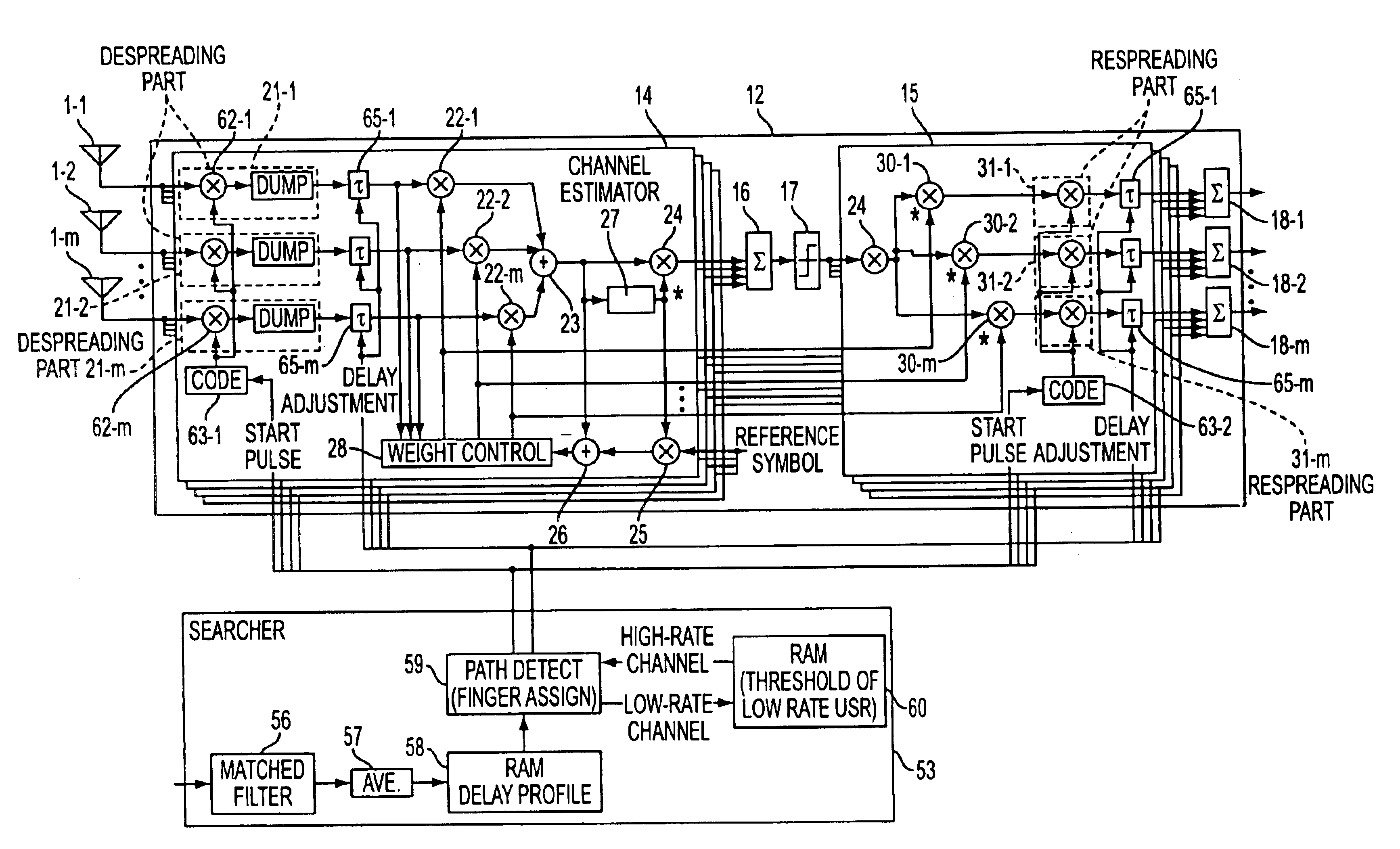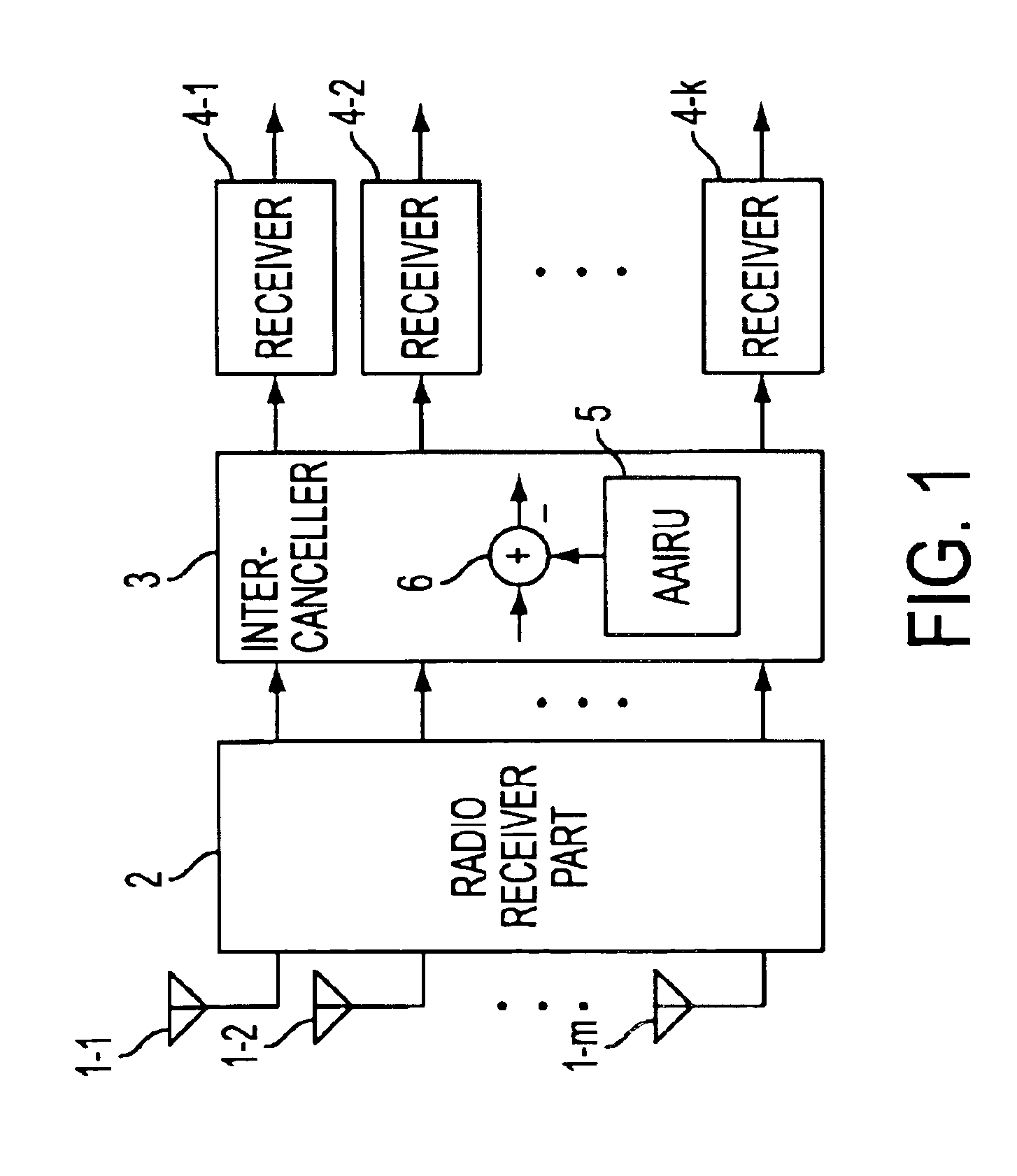Interference canceller device and radio communication device
a technology of interference canceller and radio communication device, which is applied in the direction of amplitude demodulation, line-fault/interference reduction, baseband system details, etc., can solve the problems of increasing the cost of the system, and achieve the effect of simplifying the structure of the interference canceller and reducing the cost of the radio communication devi
- Summary
- Abstract
- Description
- Claims
- Application Information
AI Technical Summary
Benefits of technology
Problems solved by technology
Method used
Image
Examples
first embodiment
[0063]FIG. 6 shows a radio communication according to the present invention. The structure shown in FIG. 6 corresponds to a receiver part of the base station in the DS-CDMA system, wherein the structure shown in FIG. 2 is applied to the receiver part. In FIG. 6, reference numbers 1-1-1-m indicate array antenna elements, 11-1-11-m indicate delay circuits (DL), 12-1-12-L array antenna interference replicating units (AAIRU) for the high-rate channels, 13-1-13-m indicate adders, 60-1-60-k indicate adaptive array receivers (AA receivers) for low-rate users, and 61 indicates an interference canceller.
[0064]The array antenna interference replicating units 12-1-12-L have the structure shown in FIG. 3, and create interference replicas of the high-rate channels. The adders 13-1-13-m subtract the interference replicas d from the received signals obtained via the delay circuits 11-1-11-m. As have been described previously, the delay circuits 11-1-11-m compensate for delays in time caused by the...
second embodiment
[0066]FIG. 7 shows a radio communication device according to the present invention. The structure shown in FIG. 7 is simpler than that shown in FIG. 6. In FIG. 7, reference numbers 71-1-71-m indicate array antenna elements, 72 indicates an interference canceller, 73 indicates a delay circuit (DL), 74-1-74-L indicate array antenna interference replicating units ((AAIRU), 75 indicates an adder, and 76-1-76-k indicate receivers of low-rate users.
[0067]The signals received via the array antenna elements 71-1-71-m are input to the array antenna interference replicating units 74-1-74-L. The signal received via the array antenna element 71-1 is input to the receivers 76-1-76-k, via the delay circuit 73 and the adder 75. The adder 75 subtracts the interference replicating d from the array antenna interference replicating units 74-1-74-L from the signal obtained via the delay circuit 73, so that interference of the high-rate channels having high transmission power are eliminated. The interfe...
third embodiment
[0068]FIG. 8 shows a radio communication device according to the present invention. In this figure, reference numbers 81-1-81-m indicate array antenna elements, 82 indicates an interference canceller, 83-1-83-m indicate delay circuits (DL), 84-1-84-L indicate array antenna interference replicating units (AAIRU), 85-1-85-m indicate adders, 86-1-86-k indicate adaptive array receivers (AA receivers) for low rate users, and 87-1-87-L indicate adaptive array receivers (AA receivers) for high-rate users.
[0069]The array antenna interference replicating units 84-1-84-L have a structure similar to that of the array antenna interference replicating units in the aforementioned embodiments of the present invention. Signals received via the array antenna elements 81-1-81-m are applied to the array antenna interference replicating units 84-1-84-L. Hence, interference replicas of the high-rate channels and symbol replicas are created. The interference replicas thus created are respectively applied...
PUM
 Login to View More
Login to View More Abstract
Description
Claims
Application Information
 Login to View More
Login to View More - R&D
- Intellectual Property
- Life Sciences
- Materials
- Tech Scout
- Unparalleled Data Quality
- Higher Quality Content
- 60% Fewer Hallucinations
Browse by: Latest US Patents, China's latest patents, Technical Efficacy Thesaurus, Application Domain, Technology Topic, Popular Technical Reports.
© 2025 PatSnap. All rights reserved.Legal|Privacy policy|Modern Slavery Act Transparency Statement|Sitemap|About US| Contact US: help@patsnap.com



